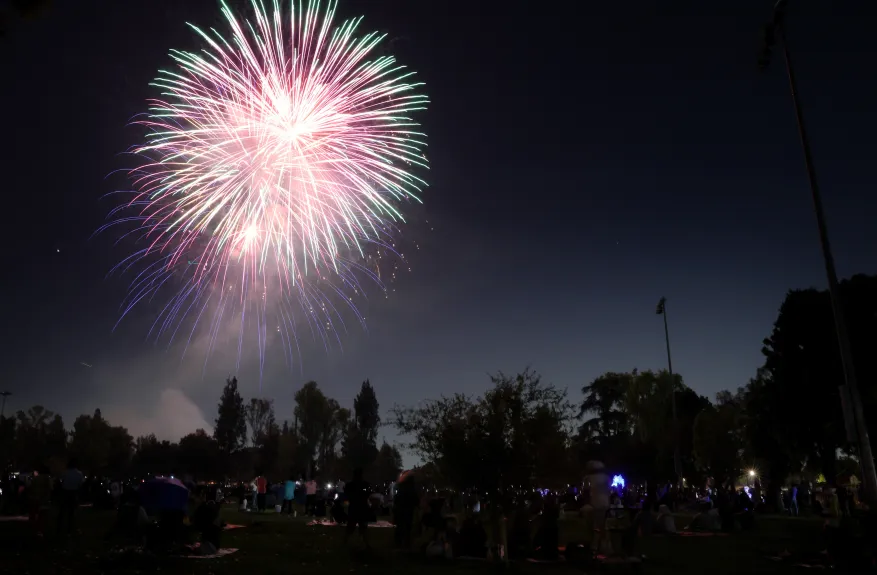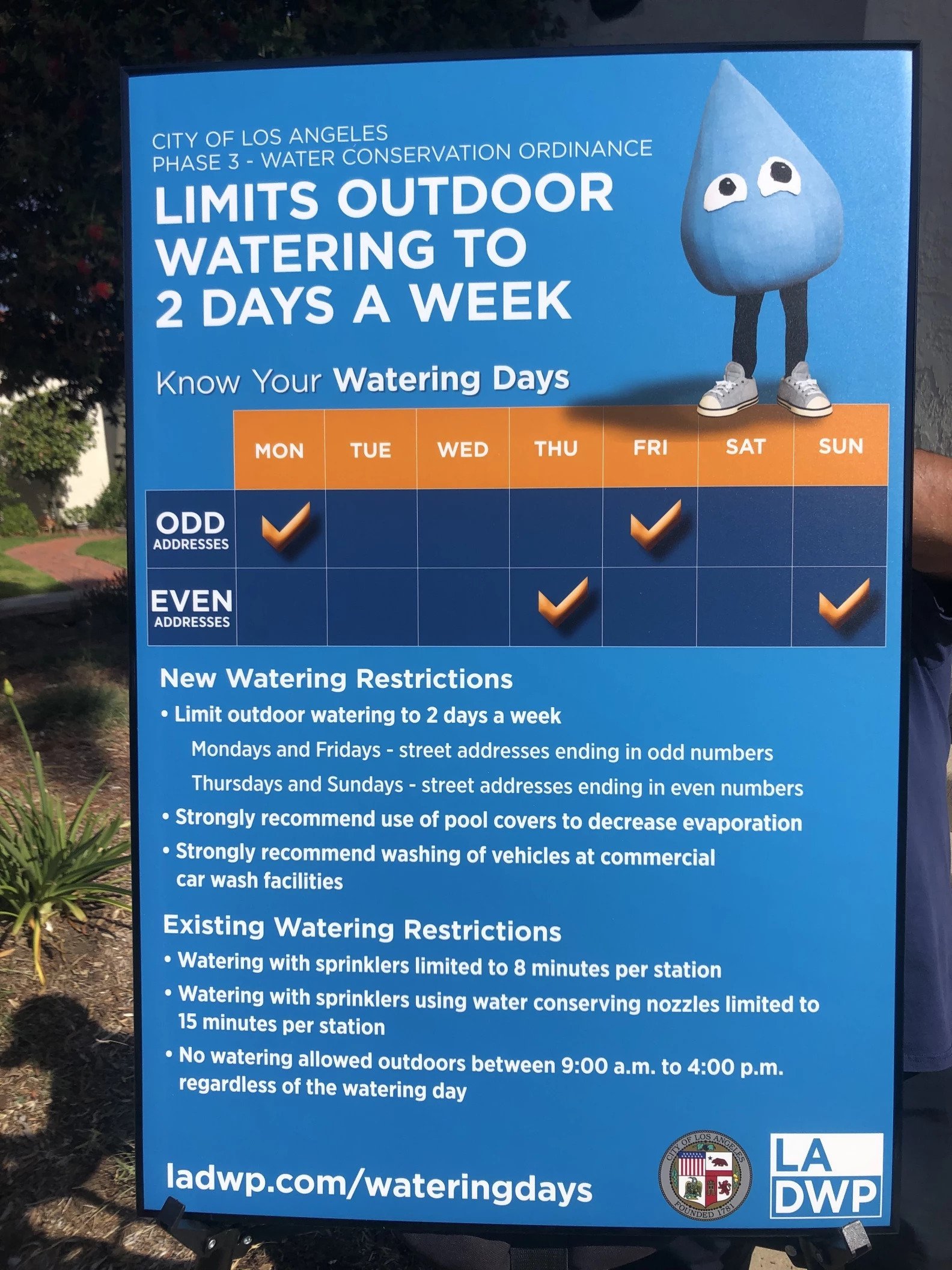
- Starting June 1, LADWP customers will have to cut their number of outdoor watering days from three to two. The rules, announced today, came in response to restrictions two weeks ago by the Metropolitan Water District of Southern California in light of this historic climate change-exacerbated drought.
- “We have plenty of water if we all do the right thing,” said Mayor Eric Garcetti at the news conference announcing the restrictions. “If somebody sees somebody watering on the wrong day or multiple days, we’ll work with those folks to educate them first…You can always get a fine, but that’s not where we’ll start.”
- LADWP customers with an odd-numbered address will be allowed to do their outdoor watering on Mondays and Fridays, while customers with an even-numbered address will have Thursdays and Sundays.
The Metropolitan Water District of Southern California announced that six million of us in the Southland will need to drastically cut water use due to unprecedented drought made worse by the climate crisis. L.A. revealed on Tuesday how it’ll meet those requirements. Here’s what the new rules are:
If your water bill comes from the L.A. Department of Water and Power (LADWP), you’ll be under new water rules starting June 1. Those rules require all LADWP customers to cut the number of outdoor watering days from three to two.
- If your street address ends with an odd number, you’ll only be able to water Mondays and Fridays.
- If it ends with an even number, you can water Thursdays and Sundays.
Water restrictions that are already in effect, and remain so, include:
- Watering with sprinklers limited to 8 minutes per station
- Watering with sprinklers using water-conserving nozzles limited to 15 minutes per station
- No watering is allowed outdoors between 9 a.m. to 4 p.m. regardless of the watering day.
One exception: You can still water trees by hand as needed—with a hot summer on its way, no one wants shade trees dying. You just can’t use automatic irrigation to keep them alive.
To enforce the new rules, LADWP will add personnel to their Water Conservation Response Unit and boost patrols. Residents and businesses that don’t comply will first be warned and could face fines for multiple violations, though that will be the last resort, officials said.
“We have plenty of water if we all do the right thing,” said Mayor Eric Garcetti at a press conference announcing the new rules on Tuesday. “We actually would like people to be compliant. We’d like them to figure out that it’s in their interest. If somebody sees somebody watering on the wrong day or multiple days, we’ll work with those folks to educate them first…You can always get a fine, but that’s not where we’ll start.”
During the last drought that ended in 2016, 99% of Angelenos ended up compliant, Garcetti said. The new rules aim to further reduce usage by about seven gallons a day per person, which is the equivalent of reducing showering time by four minutes, or shutting the faucet off during a 2-minute tooth brushing cycle and 5-minute shaving cycle, according to the city.
The rules are less stringent than in other areas that are required to water only once a week because Angelenos are already conserving a lot: Garcetti said water use per capita dropped 20% during the last drought and most of those water-cutting habits and mandates have remained.
L.A. gets most of its water from Northern California and the Colorado River, which are both facing severe drought. The new restrictions are just one of many strategies the city is using to reduce water use long-term. Other long-term strategies include bolstering local supplies by recycling all wastewater by 2035 and stormwater capture.
In a statement, L.A. Mayor Eric Garcetti said this is just one part of a larger effort to conserve water. “Regardless of how much we’ve already done, today is about recognizing how much further we have to go,” he said. “If we want our children and grandchildren to be able to turn to the tap with confidence, we need to double down on the solutions that have made conservation a way of life in L.A.”
Still, the new restrictions mean many Angelenos may see lawns go brown this summer. But the drought is also an opportunity for Angelenos to learn to love the floral scent of native plants instead of fresh-cut grass.
“The decorative lawns that we have absorb so much unnecessary water that we would love to use in this drought for other places,” said Garcetti. “The new twice-weekly rule is another compelling reason for Angelenos to replace their thirsty lawns with beautiful, drought-tolerant landscapes.”
Landscape irrigation makes up about 35% of LADWP’s total water use, according to the city.LADWP offers many rebate programs to help Angelenos pay to replace lawns with drought-friendly plants that support local pollinators. They also have rebates to replace appliances such as toilets and dishwashers to save more water. Here’s a list of some of the rebates:
- Up to $15,000 to replace grass with native plants: $3 per square foot rebate for turf/grass replacement for up to 5,000 square feet per project for residential and commercial customers;
- $500 for high-efficiency clothes washers, which increased by $100 last month;
- $250 for high-efficiency toilets, which also increased by $100 last month;
- $500 for zero and ultra-low water urinals;
- $6 for rotating sprinkler nozzles;
- Free bathroom and kitchen faucet aerators;
- Free high-efficiency showerheads;
- $5 million allocated by LADWP to offer discounts on real-time water use monitoring devices;
- And up to $2 million through the Technical Assistance Program (TAP), which incentivizes large conservation projects for commercial and industrial customers, up from $250,000 earlier this year.
Helpful Links


